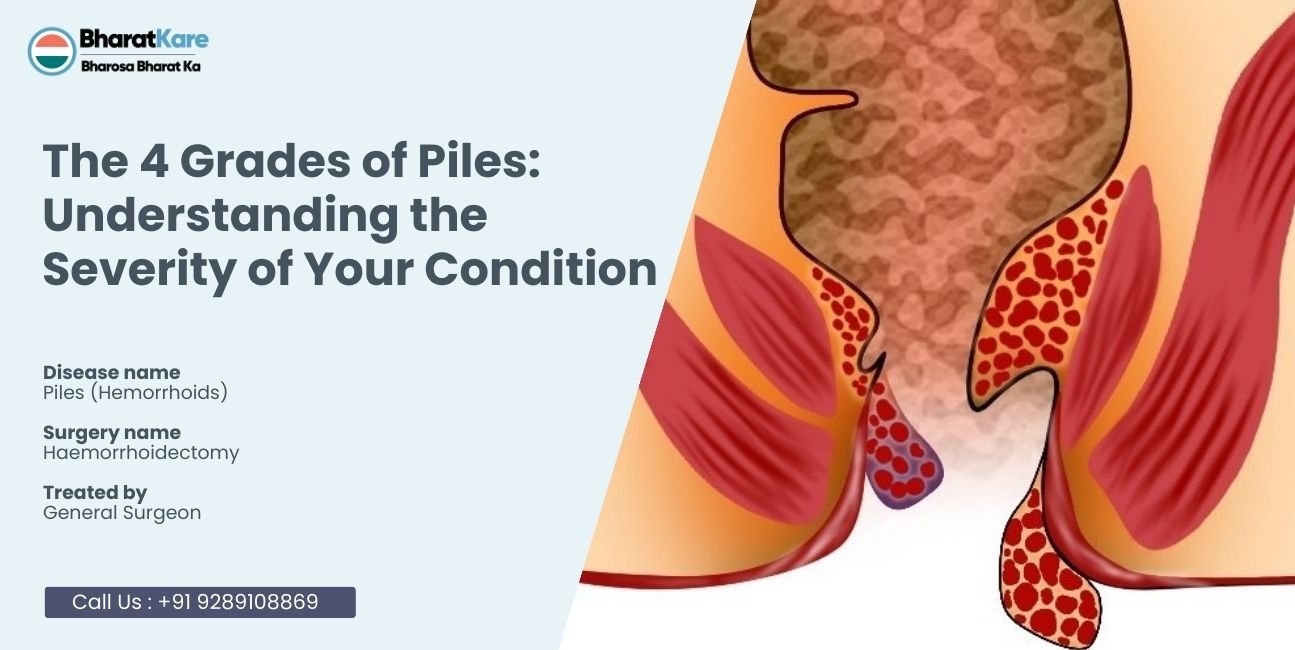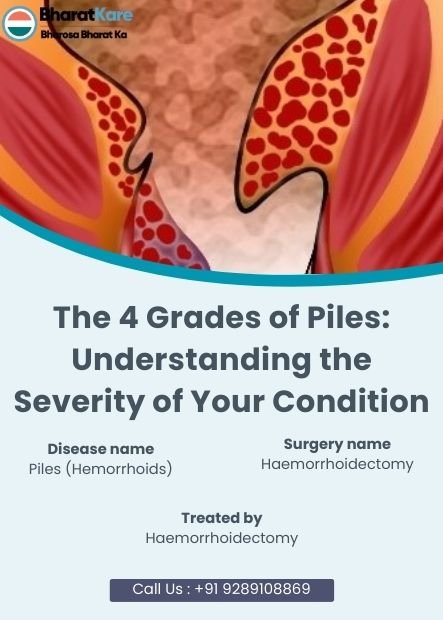The 4 Grades of Piles: Understanding the Severity of Your Condition
Let me be honest with you – hemorrhoids aren’t exactly dinner table conversation. But here’s the thing: nearly three out of four adults will experience this condition at some point. And trust me, when it happens to you, suddenly it becomes very important to understand what you’re dealing with.
I’ve spent years helping patients understand The 4 Grades of Piles, and honestly? Most people wish they’d known this information sooner. It could have saved them weeks of worry and unnecessary discomfort. So let’s dive into what these 4 Grades of Piles actually mean for you.
Let’s Talk About What’s Really Going On Down There
Before we get into the nitty-gritty of the 4 Grades of Piles, let’s clear something up. Piles (or hemorrhoids, if we’re being medical about it) are basically swollen blood vessels in your bottom area. Think of them like varicose veins, but in a place you really don’t want them.
They happen when there’s too much pressure pushing on these blood vessels. Maybe you’ve been sitting at your desk job for years, dealing with chronic constipation, or perhaps pregnancy put extra strain on everything down there. Life has a way of catching up with us, doesn’t it?
Here’s what really matters: the 4 Grades of Piles classification helps doctors figure out exactly what’s happening and, more importantly, what they can do about it. It’s not just medical jargon – it’s actually your roadmap to feeling better.


Breaking Down The 4 Grades of Piles System
Doctors didn’t just randomly decide on these grades. The 4 Grades of Piles classification came from years of treating thousands of patients and figuring out what works best for each situation. It’s like having a GPS for your treatment journey – you need to know where you are before you can figure out how to get where you want to go.
Each grade in the 4 Grades of Piles system tells us two crucial things: how much tissue is involved and what’s likely to work best. Think of it as going from annoying but manageable to we need to do something about this right now.
Don’t ignore the discomfort—consult a The 4 Grades of Piles. Book your appointment today!
Grade 1: The Maybe I Should Pay Attention to This Stage
Ah, Grade 1 – the sneaky one. You know something’s not quite right, but it’s not screaming for attention yet. Within the 4 Grades of Piles system, this is your early warning signal.
Here’s what you’ll notice: bright red blood when you wipe (scary the first time, I know), some itching that seems to come and go, and that weird feeling like you didn’t quite finish your business in the bathroom. The hemorrhoids are there, hanging out inside where you can’t see them, but they’re not bold enough to make an appearance outside.
The good news? This early stage of the 4 Grades of Piles is like catching a small leak before it becomes a flood. Most of my patients get complete relief just by changing what they eat and how they live. We’re talking weeks, not months, before you forget this was ever a problem.
I usually tell people at this stage: “Your body is sending you a memo. Time to listen.” Add more fiber to your diet, drink water like it’s your job, and start taking walks after dinner. Your future self will thank you.
Grade 2: The Okay, Now I’m Paying Attention Phase
Grade 2 is where things get interesting within the 4 Grades of Piles. Now those hemorrhoids are playing peek-a-boo – they pop out during bowel movements but politely retreat back inside on their own. It’s like they’re testing the waters.
You’ll definitely notice more bleeding now, and that itching becomes less of an occasional annoyance and more of a regular companion. Some people describe feeling like there’s something “in the way” down there. The tissue might be visible when you’re straining (which, let’s face it, is probably part of how you got here in the first place).
But here’s the silver lining in this stage of the 4 Grades of Piles: we’ve got some really clever, minimally invasive tricks up our sleeves. Rubber band ligation sounds scary but it’s actually pretty straightforward – we basically cut off the blood supply to the hemorrhoid and it withers away. Most people are back to normal activities the next day.
Grade 3: The This Is Definitely a Problem Territory
Welcome to Grade 3, where subtlety goes out the window. These hemorrhoids have decided they like the outside world and need a little push from you to go back where they belong. Within the 4 Grades of Piles classification, this is where we start talking more seriously about your options.
The bleeding is more noticeable now – we’re not just talking about a few spots on the toilet paper anymore. Sitting becomes uncomfortable, and you might find yourself constantly aware of what’s going on down there. Some patients tell me they feel like they’re sitting on a marble.
Here’s where experience really matters in the 4 Grades of Piles treatment approach. Sometimes we can still use those minimally invasive procedures, but often we’re looking at surgical options. Don’t let that scare you – modern techniques are light-years ahead of what your grandfather might have experienced. We’re talking about day surgery with most people back to work within a week.
Grade 4: The Let’s Fix This Right Now Stage
Grade 4 is the final boss of the 4 Grades of Piles. These hemorrhoids have moved out permanently – they’re not going back inside no matter what you do. It’s like they’ve set up camp and decided they’re staying.
This stage can really impact your quality of life. Sitting hurts, walking can be uncomfortable, and maintaining proper hygiene becomes a challenge. Some people describe it as constantly feeling like they’re carrying something they can’t put down.
But here’s what I want you to know about this final stage of the 4 Grades of Piles: we have excellent surgical solutions. Yes, it means an operation, but the relief afterward is often life-changing. I’ve had patients tell me they wish they’d done it sooner instead of suffering for months or even years.
The Different Types of Piles – Location Matters
Now, here’s something that confuses a lot of people: not all types of piles are created equal. We’ve got internal ones (above a certain line inside your rectum) and external ones (below that line, under the skin). The 4 Grades of Piles system I’ve been talking about? That’s specifically for the internal variety.
- Internal hemorrhoids are the ones that follow our grading system. They’re covered in the same type of tissue that lines your intestines, which is why they don’t hurt as much – there aren’t many pain receptors up there. The bleeding and prolapse are their calling cards.
- External hemorrhoids are a different beast entirely. These little troublemakers are under regular skin, complete with all those pain receptors. When they get angry (especially if a blood clot forms inside them), they can hurt like nothing else. They don’t prolapse because they’re already outside, but boy, can they swell up and make your life miserable.
Then there are mixed hemorrhoids – because why keep things simple? These are when you’ve got both internal and external components happening at the same time. It’s like your body decided to go all-out on the hemorrhoid experience.
Don’t ignore the discomfort—consult a The 4 Grades of Piles. Book your appointment today!
When Should You Actually Worry?
Look, I get it. Nobody wants to march into a doctor’s office and announce their bathroom troubles. But there are some red flags that mean you need to swallow your embarrassment and get checked out.
Severe pain that doesn’t let up, bleeding that’s more than just a few spots, or if you can see tissue that won’t go back inside – these are your cues to pick up the phone. And if you’re having other symptoms like unexplained weight loss or changes in your bowel habits that stick around, those need attention too.
The thing about the 4 Grades of Piles is that early intervention can save you from progressing to the more serious stages. I’ve seen too many people suffer needlessly because they were too embarrassed to ask for help.
How Treatment Has Changed (Thank Goodness)
The evolution of treatments for the 4 Grades of Piles has been remarkable. Twenty years ago, hemorrhoid surgery had a reputation that made people run for the hills. Today? Most of our procedures are done as outpatients, and people are back to their normal routines much faster.
For the early stages of the 4 Grades of Piles, we’re still big believers in the basics: fiber supplements, lifestyle changes, and topical treatments. Sometimes the old-school approaches work best.
When things get more serious, we’ve got procedures that sound space-age but are actually pretty straightforward. Infrared coagulation uses heat to shrink hemorrhoids. Sclerotherapy involves injecting a solution that makes them shrivel up. These aren’t the medieval torture devices some people imagine.
For advanced cases within the 4 Grades of Piles, even surgery has gotten much more civilized. Techniques like stapled hemorrhoidopexy and laser procedures have dramatically reduced pain and recovery time. Some of my patients are back to desk jobs within days.
Real Talk About Prevention
Here’s something I’ve learned after years of treating the 4 Grades of Piles: prevention isn’t sexy, but it sure beats the alternative. Most of the lifestyle factors that contribute to hemorrhoids are things we can actually control.
- Diet matters more than you think. I’m not talking about some complicated elimination diet – just get more fiber in your system. Fruits, vegetables, whole grains. Your digestive system will thank you, and you’ll spend less time straining on the toilet.
- Movement is medicine. If you’re chained to a desk all day, your circulation suffers. Even a five-minute walk every hour can make a difference. Your hemorrhoids don’t care if you’re busy – they respond to blood flow.
- Bathroom habits need an upgrade. Stop bringing your phone to the toilet. I’m serious. That “quick scroll through social media” turns into twenty minutes of pressure on all the wrong places. Get in, take care of business, get out.
What Recovery Really Looks Like
Let’s be realistic about recovery times for the different 4 Grades of Piles treatments. If you’re dealing with Grade 1 or 2 and we catch it early, dietary changes and lifestyle modifications might make you feel better in a few weeks. It’s not instant, but it’s worth the patience.
For procedures on the more advanced stages of the 4 Grades of Piles, recovery varies. Office procedures might have you back to normal in a day or two. Surgical treatments might mean a week off work and a few weeks of being careful about heavy lifting.
The key is following post-treatment instructions. I know it’s tempting to jump back into your normal routine when you’re feeling better, but giving your body time to heal properly prevents problems down the road.
Making the Right Choice for You
Understanding the 4 Grades of Piles isn’t just academic – it’s about making informed decisions about your health. Each grade within the 4 Grades of Piles comes with different treatment options, and honestly, there’s usually more than one right answer.
Your age, overall health, pain tolerance, and lifestyle all factor into what makes sense for you. I’ve had patients choose surgical options for Grade 2 hemorrhoids because they wanted definitive treatment, and others who managed Grade 3 with conservative approaches because surgery wasn’t an option for them.
The best treatment is the one that fits your life and gets you back to feeling like yourself again. Modern medical facilities make this easier by offering multiple options and taking time to explain what each one involves.
Final Thoughts: You Don’t Have to Suffer in Silence
The 4 Grades of Piles might sound like medical mumbo-jumbo, but it’s actually your roadmap to feeling better. Whether you’re dealing with early-stage symptoms or more advanced issues, effective treatments exist for every grade within the 4 Grades of Piles system.
The biggest mistake I see people make? Waiting and hoping it’ll just go away. Early treatment for any stage of the 4 Grades of Piles is almost always easier, less expensive, and more effective than waiting until things get worse.
The different types of piles all respond well to appropriate treatment when properly diagnosed. Modern medicine has come a long way from the horror stories you might have heard. Today’s treatments are designed to get you back to your life as quickly and comfortably as possible.
Ready to stop letting hemorrhoids control your life? Specialized medical centers now offer comprehensive hemorrhoid care with the latest techniques and technologies. Don’t spend another day uncomfortable when relief could be just a consultation away. The sooner you address your symptoms, the more options you’ll have – and the faster you’ll get back to feeling like yourself again.
Remember, millions of people deal with this condition. You’re not alone, you’re not broken, and most importantly – you don’t have to just live with it. Help is available, and it’s much better than you probably think it is.
FAQ
FAQs About The 4 Grades of Piles: Answering Your Most Common Queries
Based on the context of the article, Bharatkare appears to be the name of a specialized medical center or clinic that offers comprehensive care for piles (hemorrhoids). The article suggests they use the latest techniques and technologies for treating all grades of the condition. If you are experiencing symptoms, what you should do is schedule a consultation with them or a similar specialist. A professional evaluation is the first step to getting an accurate diagnosis (determining your grade) and discussing the most effective treatment options for your specific situation.
This is most characteristic of Grade 1 piles, the earliest stage. The bleeding is typically bright red and may only appear as a few spots on the toilet paper. At this stage, the hemorrhoids are internal and not visible. The article emphasizes that this is your body's "early warning signal," and it's the best time to make lifestyle changes like adding more fiber to your diet, drinking more water, and avoiding prolonged straining to prevent progression.
The key difference is whether the prolapsed (protruding) tissue goes back on its own.
Grade 2: The hemorrhoids prolapse outside the anus during a bowel movement but retract back inside on their own afterward.
Grade 3: The hemorrhoids prolapse and do not retract on their own. They require you to manually push them back inside.
Grade 3 is considered more severe, and treatment options may shift from minimally invasive procedures to more definitive surgical solutions.
Not necessarily. The 4 Grades of Piles system specifically classifies internal hemorrhoids. The painful lumps you feel are likely external hemorrhoids. These form under the skin around the anus and are rich in pain receptors, which is why they cause significant discomfort, especially if a blood clot forms (thrombosis). They are a different type of piles but are equally important to get diagnosed and treated by a doctor.
Yes, absolutely. The article specifically highlights that treatments have evolved "light-years ahead." While severe (Grade 4) cases may still require surgery, modern techniques like stapled hemorrhoidopexy or laser procedures are minimally invasive compared to traditional surgery. They are often done as outpatient procedures with significantly less pain and much faster recovery times, allowing many people to return to desk jobs within days. For earlier grades, many effective in-office procedures (like rubber band ligation) are not surgical at all.
Quick Links
Popular Surgeries
Find Us
© Copyright BharatKare 2025. All Right Reserved.


